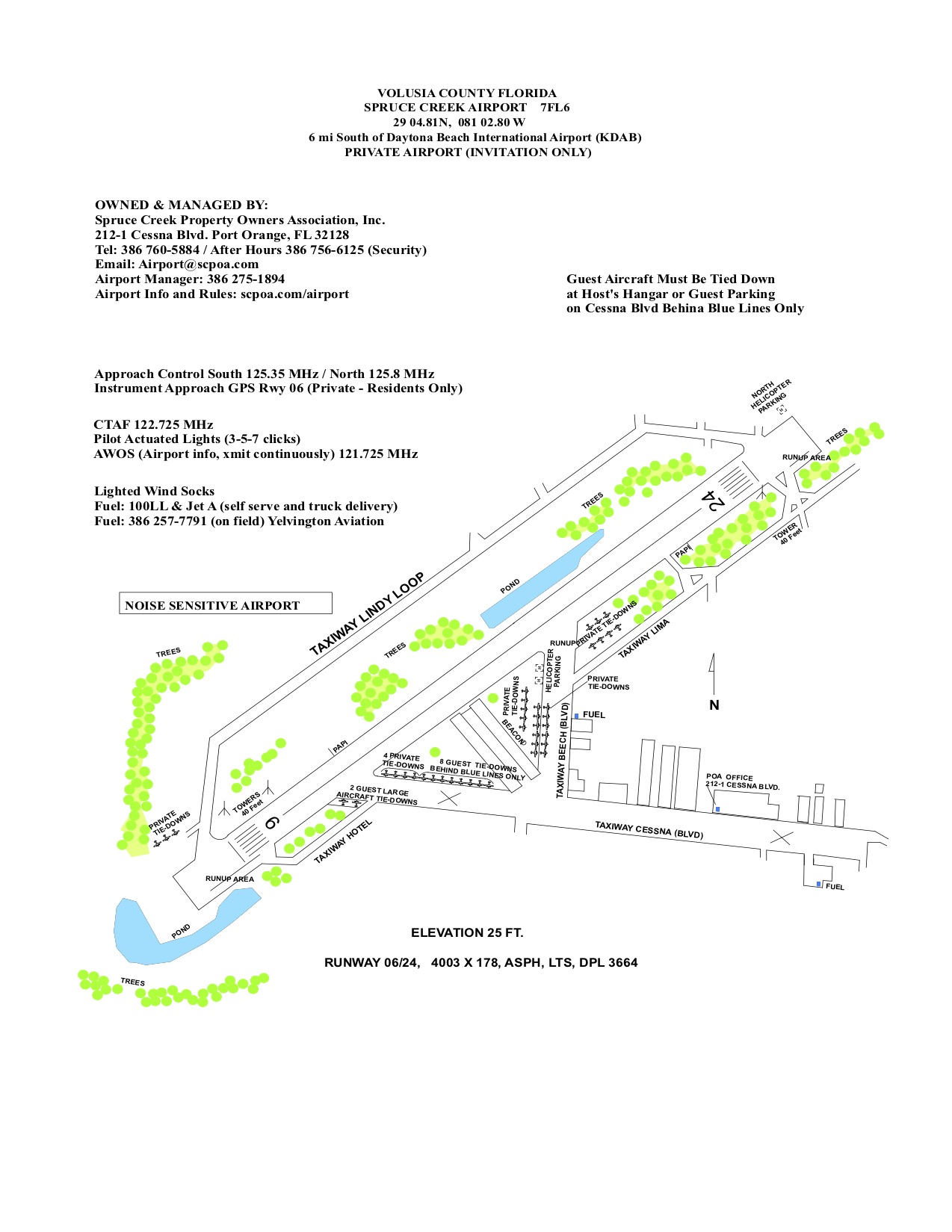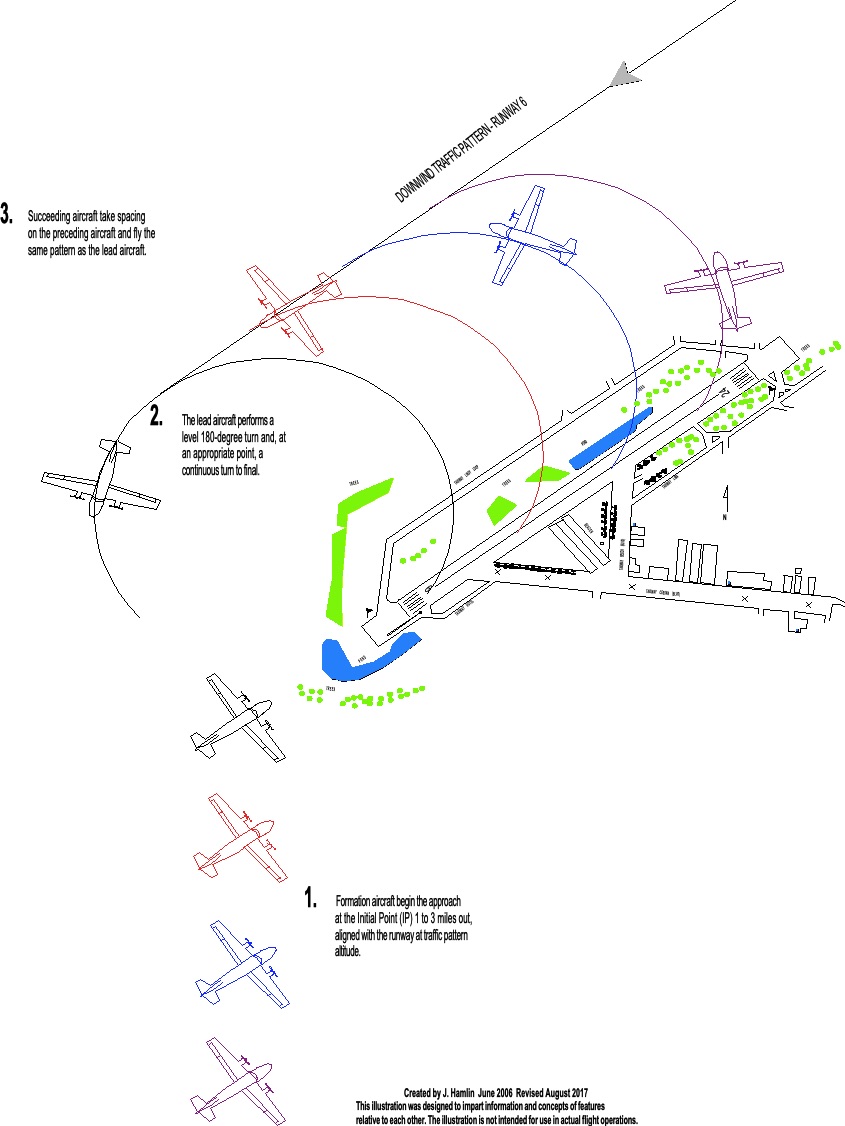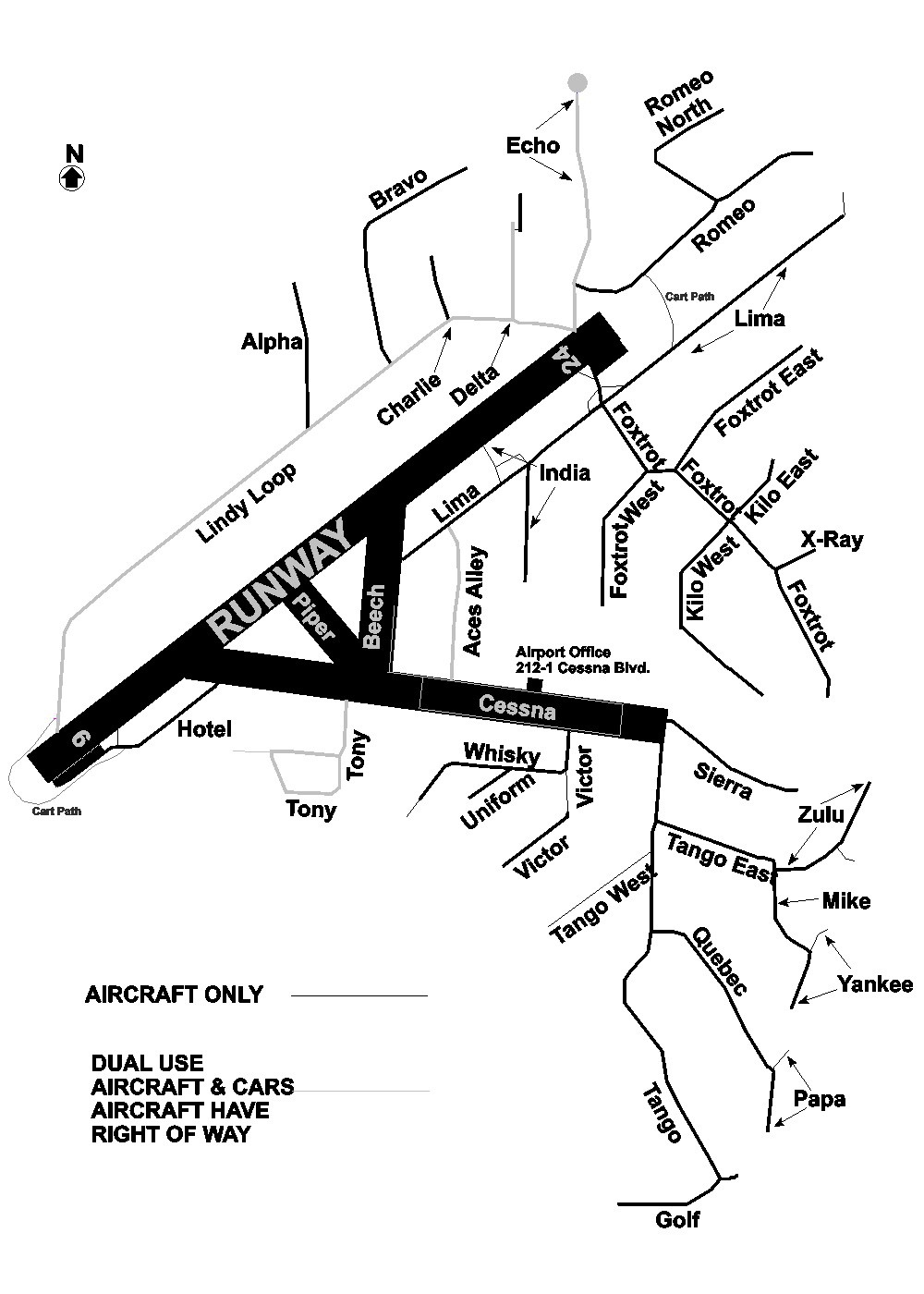Operating Procedures
The Spruce Creek Airport Authority Committee, under the authority of the SCPOA Board of Directors, develops and maintains a set of airport operating procedures for the control and safety operations of aircraft at the Spruce Creek Airport. The airport operating procedures address such issues as aircraft takeoffs, landings, and taxi, VFR traffic patterns and overhead approaches, IFR operations, helicopter and ultra-light aircraft operations, airport facilities, airport security, and on-airport aircraft parking.
RNAV Approach application form
* download, complete and submit to the RNAV Program Manager, RNAV@scpoa.com.
Spruce Creek Airport FL6 RNAV Approach FAA Letter of Authorization (LOA) Application .pdf
SPRUCE CREEK AIRPORT PROCEDURES
Contents
1. General
6. Security
8. Runway and Taxiway Inspection and Maintenance
Spruce Creek Airport Procedures
Spruce Creek Airport Authority Committee
http://www.scpoa.com/airport
1. General
1.01 Scope
Spruce Creek Airport is a private airport owned and operated by the Spruce Creek Property Owners Association (SCPOA). The Spruce Creek Airport Authority Committee through the SCPOA Board of Directors has the authority and the responsibility to oversee the operation of the Airport. Prior permission is required to land at the Spruce Creek Airport. Call the Airport Manager for permission and parking (386) 275-1894. All flying activities at the Spruce Creek Airport are regulated by the FAA and by the recommended procedures published in the Aeronautical Information Manual and other FAA documents such as the Advisory Circulars. In addition, a limited number of local rules and procedures, described herein, have been established to promote a safe and enjoyable airport. All residents, tenants and guests are required to abide by these rules and procedures.
1.02 Windsock Park
This area is for the use and enjoyment of all residents, tenants, and guests. Its location and proximity to the runway requires special vigilance. No person or vehicles are allowed between the fence and the runway at any time, or the swale on taxiway side. All children should be kept under close supervision at all times because of the proximity to an active runway and taxiway. Pets must be on a leash. Windsock Park is accessed by way of Cessna Blvd., an active taxiway. Taxiing on the grass area is prohibited.
1.03 Spruce Creek Airport Use Requirements
This is a private airport operating under a renewable Private Airport Registration and Site Approval issued by the State of Florida. Rules and restrictions imposed by this Registration govern its use. Implicit in operating at the Spruce Creek Airport: You are giving consent to the SCPOA to clear the runway in case of an incident/accident. All aircraft operating at the Airport must have liability insurance.
It is the responsibility of the resident or tenant extending an invitation to make all invitee pilots aware of the transit parking locations, restrictions, operating rules, and procedures contained within this document.
All aircraft parking on the ramp must display a name and phone number of aircraft Guest Pilot and Spruce Creek Sponsor on the glare shield.
By using the Spruce Creek Airport and facilities you indicate your acceptance of and agree to be bound by the terms of the Spruce Creek Airport Procedures and any subsequent amendments.
1.04 Runway Description
The asphalt runway is designated 06/24 and is 3998 feet long and 176 feet wide at an elevation of 25 feet MSL. The threshold is displaced for landing on Rwy 06 and Rwy 24 by 350ft. There is 3,650ft. remaining on both runways. Maximum aircraft operating weight is 30,000 pounds.
1.05 Communications
All pilots are strongly encouraged to equip their aircraft with a VHF radio and to use radio procedures recommended in the FAA Advisory Circular for non-towered airports. The assigned Unicom frequency is 122.725 MHz. This is used as the Common Advisory Frequency (CTAF). Airport Weather information is available on 121.725 MHz.
1.06 Reference Publications
Federal Aviation Regulations, TSA Regulations, Aeronautical Information Manual, and Advisory Circulars, form the basis for all flight operations and airport operating procedures.
1.07 Noise Sensitive Area
Pilots should be aware that the area around Spruce Creek Fly-In is noise sensitive. Housing areas, schools, etc., should be avoided to the extent possible and practical.
1.08 Airport Safety
Smoking within fifty feet of any fuel truck or aircraft fueling facility is unsafe and is therefore not permitted.
2. Ground Operations
2.01 Taxiing
Pilots will taxi at a reasonable and safe speed. The speed limit on all taxiways and ramp areas is 15 mph. Use taxi/landing lights at all times.
Aircraft always have the right of way.
2.02 Runway Selection
The Calm Wind Runway is 24, calm winds are less than 3 knots. This had been voted on by the POA Board and is now permanent. It is the pilots’ responsibility to determine the appropriate runway to use and to make proper and accurate radio calls.
2.03 Engine Run-up
Normal engine run-up is restricted to the established run-up pads on the south side ends of Rwys. 6 and 24. Maintenance run-ups are permitted only at the normal run-up pads or on taxiway Beech by the Helicopter Pad at the runway intersection. Pilots shall exercise good judgment in attempting to minimize the effects of prop wash/jet blast and noise production during run-up.
Runways 6/24 Run-up Areas
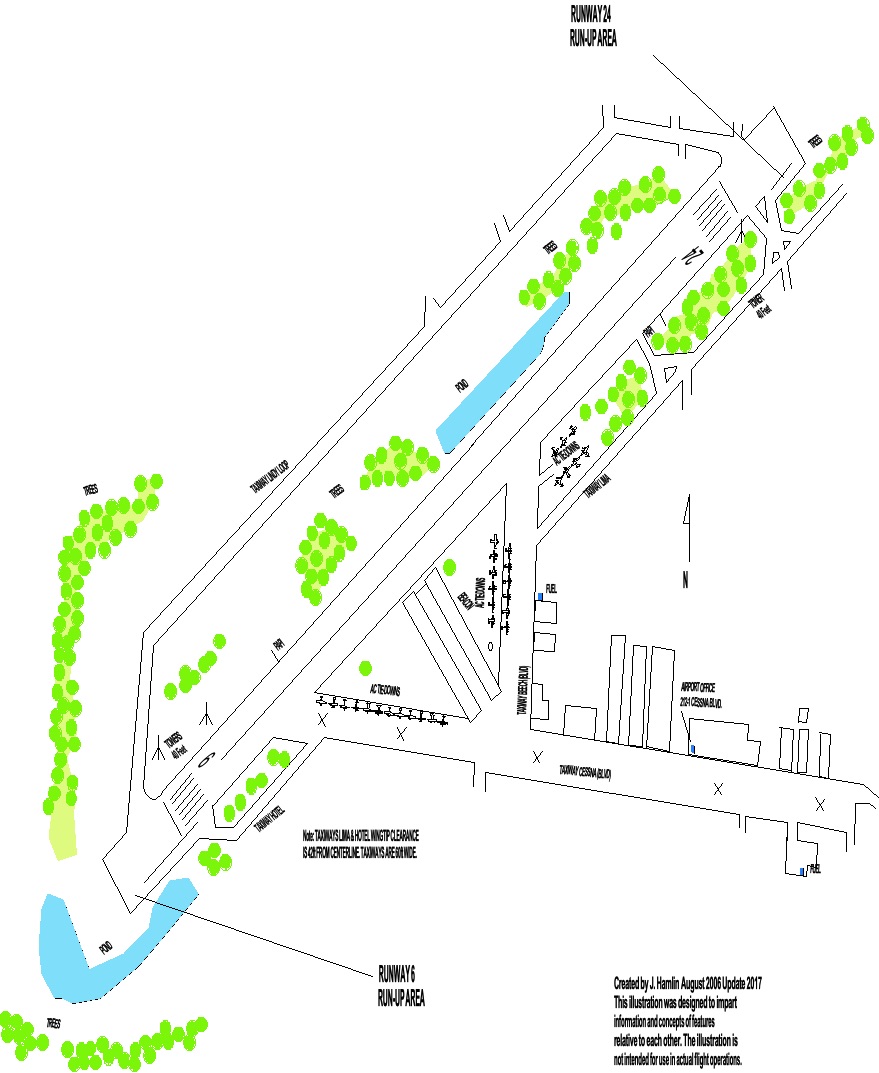
2.04 Back Taxiing
Only aircraft unable to use taxiways because of wing tip clearance or gear track, are permitted to back taxi.
When on the runway use landing lights and radio coordination with other departing and landing traffic.
3. Flight Operations
(Compliance with FAA AC 90-66B required)
Pilots are encouraged to always use landing lights for Taxi, Takeoffs and Landings
3.01 Takeoffs
All fixed wing aircraft are encouraged to use the full length of the runway to provide the greatest margin of safety in the event of an emergency.
3.02 Noise Abatement
Departing aircraft shall climb on runway heading to 500 feet AGL and beyond the departure end of the runway before making any turns and climb to the pattern altitude of 1000 ft as quickly as possible. Pilots shall use noise abatement climb procedures including after-takeoff power and prop speed reductions consistent with safe operating practices and techniques.
3.03 Temporary Flight Restrictions
TFRs are frequently imposed on flight operations at and near the Airport. Pilots shall check with Flight Service or other facilities for current TFR information.
3.04 Departures Restrictions
Departing aircraft shall climb on runway heading to 500 feet AGL and beyond the departure end of the runway before making any turns and climb to the pattern altitude of 1000 ft as quickly as possible. Pilots shall use noise abatement climb procedures including after-takeoff power and prop speed reductions consistent with safe operating practices and techniques. All VFR departures must be conscious of the configurations of the Daytona Beach (DAB) Class C airspace and New Smyrna Beach (EVB) Class D airspace and their effect on flight operations at the Airport. Radio contact with the appropriate facility is required prior to penetrating DAB Class C or EVB Class D airspace.
3.05 Night Operations
During the hours of darkness, if runway lights are inoperative, the runway is closed. Night proficiency flying should be completed by 10 P.M. local time. If flying is necessary between 10 P.M. and 7 A.M., please consider your neighbors by keeping noise to a minimum.
3.06 Flight Training
Residents - Only Residents (Both Student and CFI) of Spruce Creek are permitted to train at the Airport. (It is suggested to leave the Airport area for all training purposes) All simulated emergencies are strongly discouraged. This includes power reductions to simulate engine failure, as well as any other simulation that might distract a pilot during takeoff, departure, approach, or landing.
Non-Residents - Non-resident pilots and/or students renting or leasing aircraft from a Resident of Spruce Creek Fly-In must adhere to the following rules:
- Only US Certified Instructors or Pilots are allowed to Takeoff or Land at the Airport.
- All training including Touch & Go's must be conducted away from the Airport.
- No Simulated Emergencies to be conducted at the Airport.
3.07 VFR Operations
Arrivals - Arriving aircraft should monitor AWOS on 121.725 MHz for airport weather information. Pilots are expected to monitor and make appropriate radio calls (with type, location and color of aircraft included.) and announce intentions on the local CTAF frequency 122.725 MHz. All arriving aircraft shall fly a Standard Left-Hand Traffic pattern at 1000 feet AGL(91.126(b)(1).
Runways 6/24 Standard Left Hand Traffic Pattern
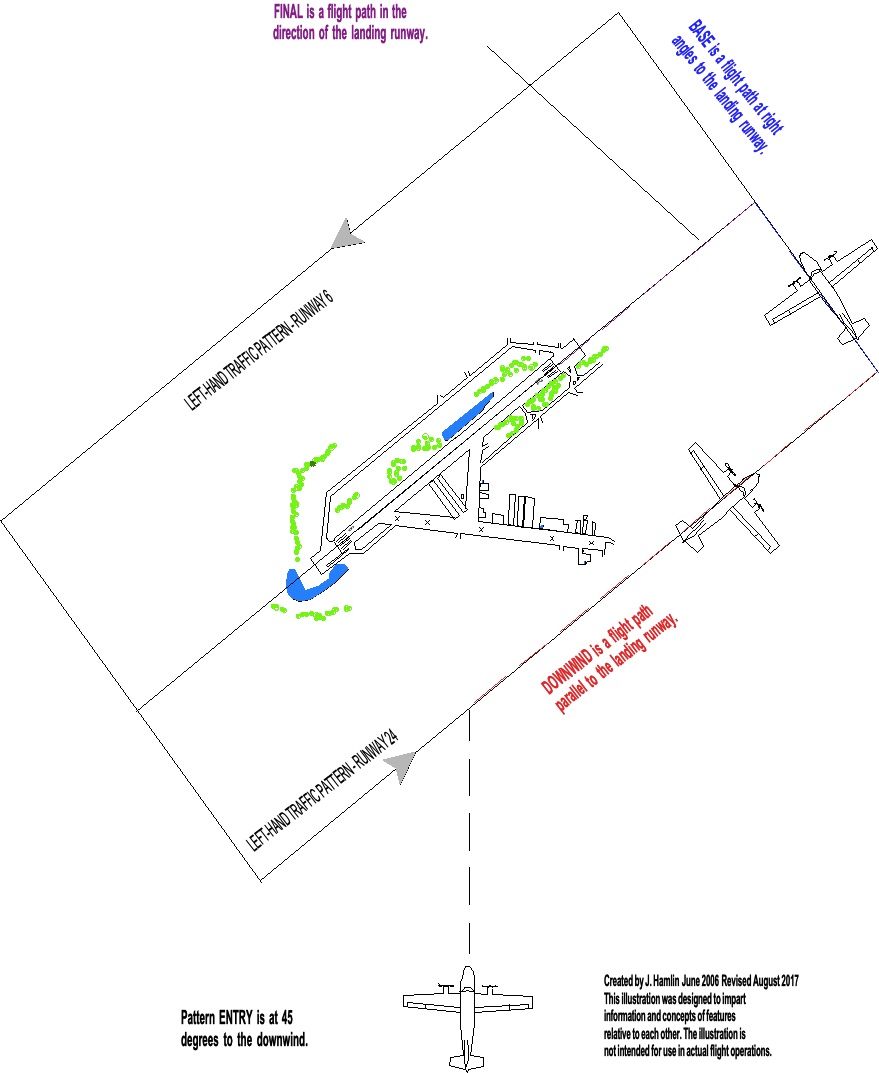
Overhead Approach- Overhead approaches are normally used for formation flights. However they are not given priority over other traffic. Formation flight leaders are expected to take adequate spacing on other traffic in the pattern. Treat all aircraft in the formation as a single unit and do not sequence your plane within the formation unit. Common sense and normal courtesy should be exercised to resolve traffic pattern conflicts.
An overhead approach consists of an Initial Point (IP) 1 to 3 miles out that is aligned with the runway. Aircraft then fly at traffic pattern altitude to a point overhead the approach end of the landing runway.
The lead aircraft will perform a level 180-degree turn, called the break, to downwind and at an appropriate point, a continuous turn to final. Succeeding aircraft take spacing on the preceding aircraft and fly the same pattern. Appropriate radio calls are made at the IP, the break, and base leg. You might hear on the CTAF, "Spruce Creek traffic, White flight of four, one mile initial, Runway 6." Typically, formations consist of a “flight of two”, “a flight of four”, or more aircraft.
Runways 6/24 360 Overhead Approach or Break
3.08 IFR Operations
Departures - Departing aircraft should use Daytona (DAB) METAR and Spruce Creek AWOS on 121.725 MHz for airport weather information. Pilots are expected to monitor and make appropriate radio calls to announce their intentions on the local CTAF frequency 122.725 MHz.
For IFR clearance Pilot can use Cell Phone DAB Departure Control 386 226-3912 or 386 226-3939.
Arrivals - Arriving aircraft should use AWOS on 121.725 MHz for airport weather information. Pilots are expected to monitor and make appropriate radio calls (with type, location and color of aircraft preferred) and announce intentions on the local CTAF frequency 122.725 MHz.
IFR GPS Approach - RNAV(GPS) Rwy 6 is a private approach to a private airport. Only Pilots with an approved LOA and numbered approach plate assigned in their name are authorized to use this Approach.
Cancel IFR Flight Plan in the air or with DAB Control 386 226-3912 or 386 226-3939.
3.09 Helicopter Operations
Start-Up - Helicopters must be towed to helicopter parking adjacent to the runway at Beech, Cessna, or Echo prior to start-up. Run-ups are to be conducted on the helicopter parking pad.
Helicopters With Overall Height Greater Than 15 Ft. May Not Use The North Helicopter Parking Pad
Taxiing - Hover taxiing is permitted only over the north end of Beech, the west end of Cessna, and between the runway and North Helicopter Parking Pad without prior permission by the airport manager.
Departures - After coordination with fixed wing arrival and departure traffic, helicopters should depart over the runway centerline and, after that, avoid the flow of fixed wing traffic.
No Takeoff From Or Landing To A Helicopter Parking Pad Is Permitted. Helicopter Pads Are For Parking Only. Takeoff From And Land To Runway Only
Arrivals - Approaches must be made over the centerline of the runway. Pilots are encouraged to plan the approach so as to spend minimum time on the runway. Hover taxi to a designated helicopter parking pad without delay. After shutdown, the helicopter must be towed to a suitable parking area.
Tie-down and Security - Helicopters should be secured in accordance with the manufacturers recommendations. See Advisory Circular AC 20-35 for other recommended tie-down procedures and information. To address Homeland Security and local safety and security issues, all unattended helicopters should be locked.
3.10 Ultra-Light Operations
Only Aircraft with an ICAO registered (Tail Number) and FAA or Foreign Certified Pilots are permitted to operate within the Airport traffic area.
3.11 Balloon Operations
Balloon operations are prohibited due to SCPOA insurance coverage.
4. Airport Facilities
4.01 Runway Lights
Runway lights are normally set on low from dusk to dawn. When runway lights are on, light intensity can be controlled by the pilot by activation of the mic switch on 122.725 MHz (3 times-low, 5 times-med, 7 times-high within 5 sec.).
4.02 Windsocks
Illuminated windsocks are installed at the approach left end of each runway.
4.03 Automated Weather Observing System (AWOS)
Current airport weather information is available by radio (121.725) or telephone (617-262-3825). Advisories provide altimeter, density altitude, wind direction and speed, visibility, temperature, dew point, crosswind, and wind-shear warnings.
Radio Access – AWOS is continuously transmitted on frequency 121.725 MHz. A “Radio Check” in which the system accepts a short message from the user, and echoes the same back to the user, is available after every AWOS transmission.
Telephone Access – A complete AWOS advisory can be accessed by dialing the AWOS center at 617-262-3825 and when prompted for an airport, dial 7356# for (7FL6).
4.04 Precision Approach Path Indicator (PAPI)
A standard, steady-state, Precision Approach Path Indicator (PAPI) is installed on the left side of each runway.
5. Emergency Procedures
5.01 Airport Emergency Response Procedures
An Emergency Procedures manual has been published by the Spruce Creek Airport Authority Committee, which establishes an action plan for aircraft accidents and incidents.
5.02 Aircraft Accidents
An emergency response team has been established within the community to respond to all aircraft accidents and incidents. The objective of this team is to protect life and property, avoid a secondary incident, and organize and implement necessary response actions. This will include crowd control and limiting access to the accident or incident scene. It may also include temporarily closing the airport or limiting its use.
Emergency equipment to assist with aircraft accident response, including Fire Extinguishers and Defibrillators, is available at a number of locations around Spruce Creek Airport.
Emergency Equipment Location
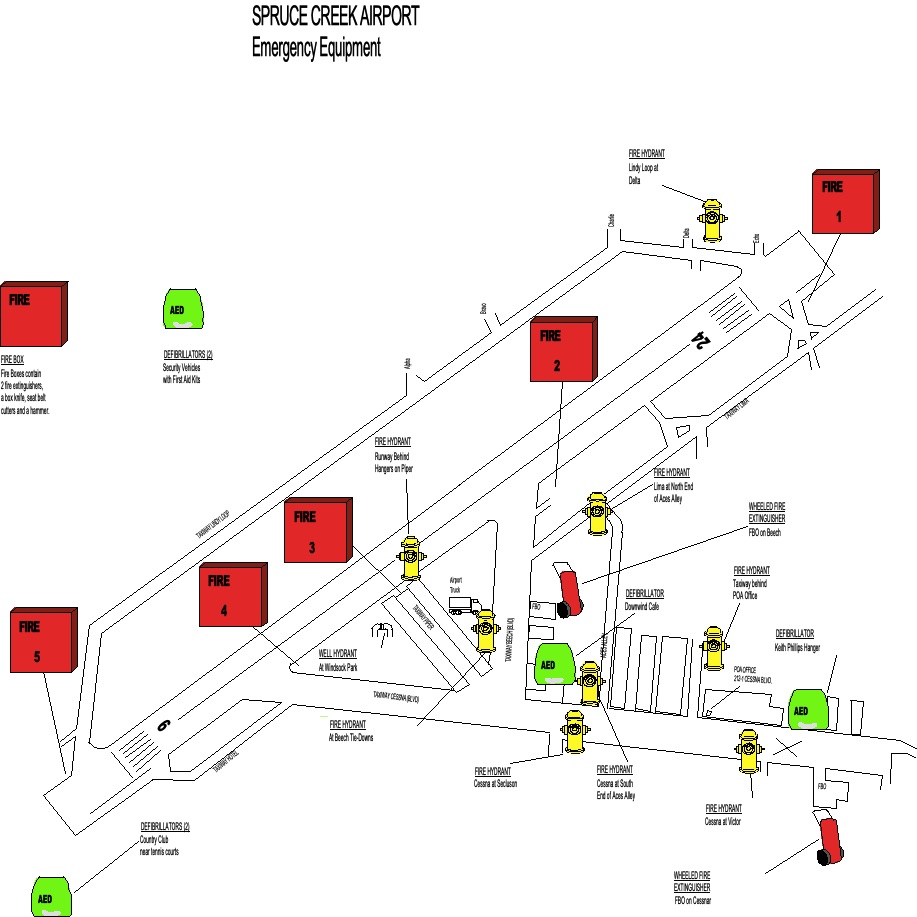
Emergency Firebox Tools
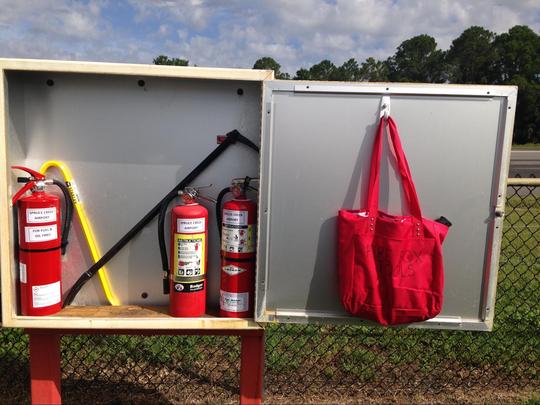
5.03 Accident or Incident Scene Access
A photo identification badge and safety vest will identify those individuals with authorized access to an accident or incident scene. All others must remain clear of the area.
6. Security
6.01 Security Issues
Runway encroachment by vehicles or individuals, vandalism of aircraft or airport facilities, unauthorized vehicles on taxiways, or other activities deemed to be a hazard or a potential hazard to aircraft operations should be reported immediately to Spruce Creek Security at (386)756-6125. Theft, vandalism or destruction of aircraft or airport facilities is a federal offense.
6.02 Pilot Communication with Security
Spruce Creek Security can be contacted on the CTAF 122.725 MHz for emergency assistance or urgent communications. This frequency is monitored 24 hours a day.
6.03 Security Cameras and Patrol
All taxiways and aircraft parking areas are patrolled and under camera surveillance by the Airport Operations and Security 24 hours a day, these cameras and audio are recorded.
6.04 Runway Access
No pedestrians or vehicles are permitted on the runway, the safety areas (within fifteen feet of the runway edge), or runway overruns (extending past the runway end) except on paved cart paths. An exception is made for specifically identified individuals and specially equipped vehicles. A photo identification badge issued by the Airport Manager or POA Manager is worn by all individuals authorized to access the runway, runway safety area, and runway overrun. Vehicles authorized runway access must, both day and night, display a flashing or rotating beacon visible 360 degrees when on the runway, runway safety areas, or runway overruns. All authorized vehicles must have a two-way communications radio and monitor 122.725 MHz. Other vehicles not so equipped must be escorted while in these restricted areas.
6.05 Taxiway Access
Vehicles - (cars and trucks) are prohibited from using all taxiways except Aces Alley, Delta, Echo, Lindy Loop, Tony, Cessna, and Beech (refer to Appendix A-6) without permission. Vehicles over 12,500 pounds GW require special use permits which may be issued by the POA to owners of recreational vehicles and other vehicles where taxiway access to a hangar is required. This permit must be displayed on the windshield of the vehicle.
Vendors and Non-Residents – In all cases, vendor and non-resident vehicles, unless issued a special use taxiway permit, must be escorted by Spruce Creek Security on taxiways other than Aces Alley, Delta, Echo, Lindy Loop, Tony, Cessna, and Beech (refer to Appendix A-6). Vendors may not operate vehicles over 12,500 pounds GW on any taxiway except Aces Alley, Delta, Echo, Lindy Loop, Tony, Cessna, and Beech without special permission from the SCPOA.
Pedestrians and Pets – Pedestrians or Golf cart operators on taxiways are not permitted to use headphones or other devices which limit the ability to hear approaching aircraft. Pets must be on a leash or otherwise confined at all times.
6.06 Taxiway Speed Limit
The maximum speed limit on all taxiways is 15 mph for vehicles and aircraft.
Aircraft Always Have The Right Of Way.
7. Aircraft Parking
7.01 Tie-down Definition
An aircraft is considered to be tied down when tail, wing, and nose tie-down rings, if provided, are anchored to the ground with a suitable size rope, strap, or chain so as to prevent movement that could cause damage to other aircraft or property. All unattended aircraft should be locked. (See Advisory Circular AC 20-35C)
7.02 Resident Parking
POA Property - POA managed aircraft tie-downs are located throughout the community and are made available to all residents on a first-come-first-serve basis. Those tie-downs are assigned and leased by the POA on an annual basis. If available, residents may lease one site and sub-leasing is not permitted. If a non-assigned aircraft is parked on a leased tie-down, Spruce Creek Security should be informed and it will be cited and charged $10.00 per each day. A car may be temporarily parked in a leased tie-down slot when the aircraft is out. The car must be parked straight in or out, not at an angle or sideways.
Private Property - Resident, tenant, and invitee aircraft parking is permitted on private property clear of taxiway setbacks and road right-of-ways. To address Homeland Security and local safety and security issues, all unattended aircraft parked on POA or private property should be tied down and locked. All invitees must register with the POA at (386) 760-5884, and or Spruce Creek Security at (386)756-6125.
7.03 Guest / Visitor Information
All flying activities at the Spruce Creek Airport are regulated by the FAA and by the recommended procedures published in the Aeronautical Information Manual (AIM). In addition, a limited number of local rules and procedures have been established to promote safety. By using the Spruce Creek Airport and facilities you indicate your acceptance of and agree to be bound by the terms of the Spruce Creek Airport Procedures and any subsequent amendments.
|
Private use. Permission required prior to landing. Permission to use the airport is obtained from the Airport Manager or from a Resident invitation. |
Airport Information Quick List
Airport Manager: Jim Stone. 386-275-1894. airport@scpoa.com
Airport Assistant Managers: Jeff Rule, Dave Corwith
| Telephone | Airport Manager 386-275-1894 |
| AFTER 1700 | 386-756-6125 (Security) |
| APCH CNTRL Daytona Beach | 125.35 MHz (South) 125.8 MHz (North) |
| INST APCH | 7FL6 RNAV RWY6 (Private, Resident Only) |
| CTAF | 122.725 MHz |
| AWOS | 121.725 MHz |
| FUEL | 100LL & JET A Self serve. Truck delivery – Yellvington Aviation 386-257-7791. Call ahead to avoid delay. |
Runway 6 / 24
| Dimensions: | 4000 x 175 ft. | ||
| Surface: | asphalt, excellent condition | ||
| Runway edge lights: | medium intensity. On dusk to dawn. 3 levels | ||
| Elevation: | 25 ft. | ||
| Traffic pattern: | 1025 ft. Left | ||
| Visual slope indicator: | 2-light PAPI on left (3.00 degrees glide path) |
Caution: Daytona Beach International Airport (KDAB) airspace above the pattern at 1200 ft MSL
VISITING AIRCRAFT PARKING & REGISTRATION
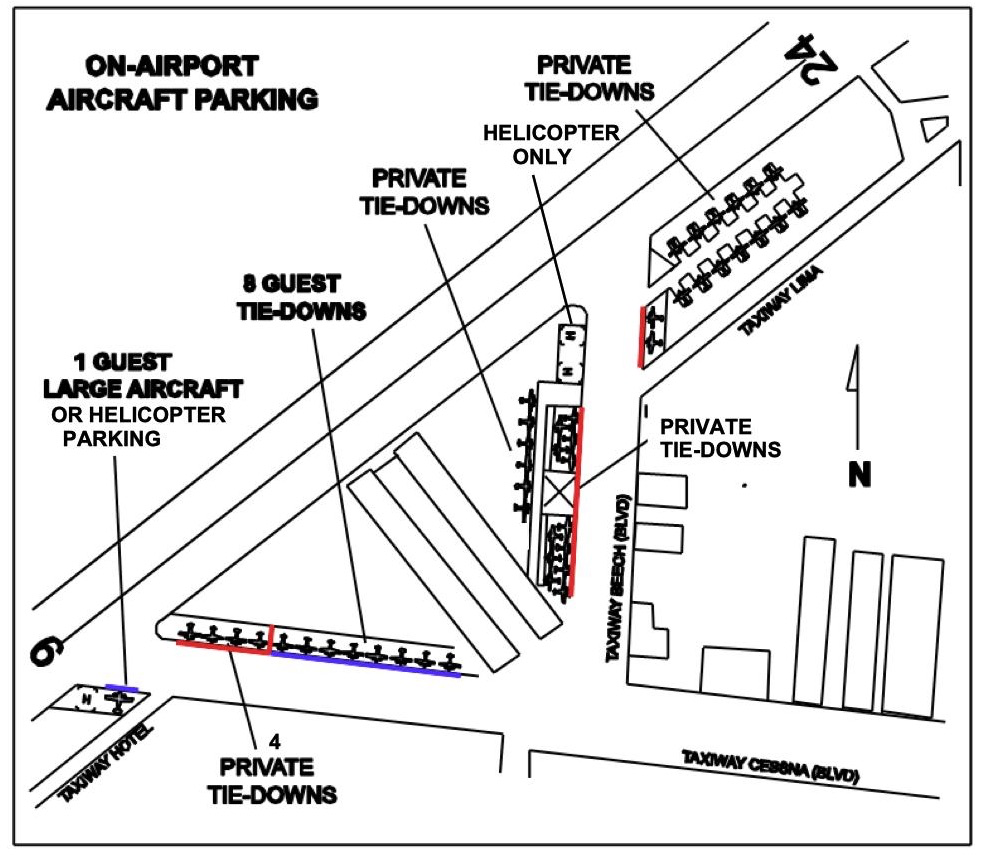 Guest/Visitor parking is available on the north side of Cessna Blvd. 8 tie-down spaces are marked by blue lines at the edge of Cessna Blvd. One tie-down space for a large visiting aircraft is available on the south side of Cessna Blvd.
Guest/Visitor parking is available on the north side of Cessna Blvd. 8 tie-down spaces are marked by blue lines at the edge of Cessna Blvd. One tie-down space for a large visiting aircraft is available on the south side of Cessna Blvd.
One Day Parking Guests/Visitors are required only to display the pilot's name and cell number in the left side windshield of the aircraft.
Overnight Guests/Visitors MUST register their aircraft by completing the Parking Form in the Drop Box near the Visitor Parking places. As a means of prudent risk management in the operation of a private airport and to address Homeland Security issues, visiting aircraft are monitored daily by Spruce Creek Security. All unauthorized aircraft are reported each morning to the Airport Manager, SCPOA Manager, and if deemed necessary Government and Local authorities.
No fee will be charged for same day parking in the Guest/Visitor parking area. The aircraft owner/operator must display the pilot's name and cell number in the left side windshield of the aircraft.
A fee will be charged for each overnight tie down in the Guest/Visitor parking area.
- Park only in the designated Guest/Visitor parking area.
- Tie down the aircraft in the center of a Guest/Visitor tie-down space
- Complete the registration form with the following information:
- Aircraft registration number
- Pilot's name, home address and phone number
- Name of the person or business you are visiting
- Pilot's local contact phone number
- Pilot's date of arrival and expected departure date
- Upon arrival Pay the parking and place in the drop box
Contact the airport manager at 386 275-1894 for further information.
Parking Fees:
Tie down parking fee of $10.00 per day is charged for single engine aircraft. A parking fee of $10.00 per day is charged for twin engine aircraft.
Do NOT park at FBO sign. Parking limited
Large aircraft with passengers must contact Airport Manager for permission and for parking spot assignment. Do not arrive without notice to Airport Manager.
Overnight Guests MUST register their aircraft by completing the Parking Form in the Drop Box near the 8 Guests tie-downs.
If guest parking is full, please use the center field grassy area near the midfield windsock.
Helicopter air taxi is not allowed on any taxiway without the approval of the airport manager. Fuel trucks are available to service helicopters at the helicopter pads.
Additional information
- Aircraft Parking information
- AirNav 7FL6 Spruce Creek Airport, Daytona Beach Florida
- Weather
- AOPA
- EAA Chapter 288 Daytona Beach
7.04 Special Event Parking
During Daytona Beach area special events (such as Speed Week, Coke 400, and Bike Week), invitee parking will be limited.
7.05 POA Security Responsibilities
The Spruce Creek Security Force monitors and logs all aircraft parking.
7.06 Aircraft Tie-Downs
There are a limited number of aircraft tie-downs located in Spruce Creek. Aircraft not parked or tied-down in accordance with the provisions of Spruce Creek Airport Procedures are subject to towing and relocation without notice at the owner’s expense. The Spruce Creek Property Owners Association and its contractors, employees and assigns have no liability for any loss or damage occasioned thereby.
8. Runway and Taxiway Inspection and Maintenance
Taxiways
The airport has approximately 8 miles of taxiways.Taxiways Beech, Cessna, and Lindy Loop are 100 feet wide. Taxiways A, B, C, and D are 50 feet wide. All other taxiways are 60 feet wide. Taxiways Beech, Cessna, Lindy Loop, D, E, Tony and Aces Alley are dual use(auto traffic is permitted, however aircraft have right of way).
8.01 Inspection
Frequent inspections of the runway and taxiways are conducted for condition, cleanliness, and condition of all visual aids. Report any observed deficiencies to the Airport Manager or the POA office (386) 760-5884
Spruce Creek Taxiways
8.02 Maintenance
Taxiway easements and right of ways are officially defined in the final drawings of the communities in which they were constructed and in the table below. Property owners, residents, and tenants should be aware of taxiway easements and right of ways on and through their property. They are responsible for maintaining obstruction-free right of way. No vehicle, equipment, or other obstructions should be left unattended on the taxiway surface or surrounding easement/right of way. Trees and shrubs must be trimmed regularly to adhere to the required clearances listed in the table below.
APPENDIX
A-1 Creek Arrival or Departure
The “Creek Arrival” and “Creek Departure” are visual procedures that can be used to arrive or depart the Spruce Creek airport to and from the ocean shoreline. These are VFR only procedures which define a ground track for inbound and outbound aircraft in the corridor between the DAB Class C and the EVB Class D airspace. Pilots should maintain appropriate altitude to comply with AC 90-66B and FAR 91.119.
Suggested example radio transmissions on the CTAF of 122.725 MHz
Inbound: “Spruce Creek traffic, Twin Comanche, Creek Arrival at the shoreline”
Outbound: “Spruce Creek traffic, Twin Comanche, Creek Departure over I-95”
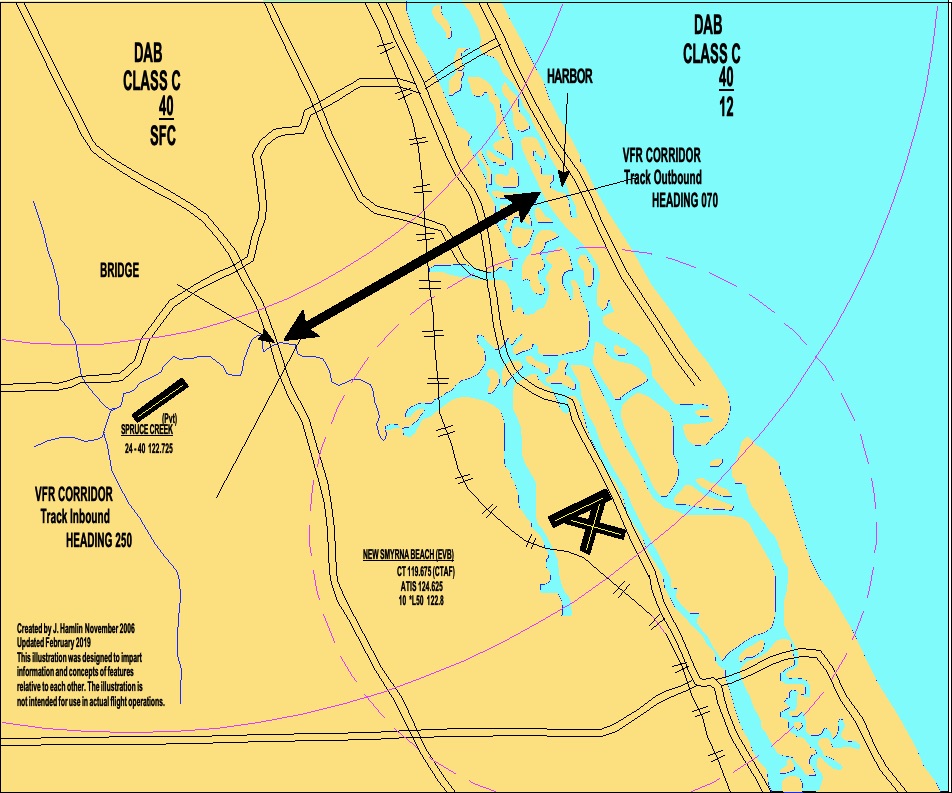
A-2 Tank Departure
The “Tank Departure” is a visual procedure to stay well clear of DAB Class C Airspace when departing Northwest. This is a VFR only procedure. Be advised that IFR traffic inbound to the DAB ILS 7L will be at 1,600' in the vicinity of the Tank.
Departure from Runway 24:
After departure, turn right, recommended altitude not above 1000 feet, fly over the tank, then fly heading 290° until crossing I-4 and SR-92 (both major east-west roads), then on course.
Departure from Runway 6:
After departure, enter left downwind, when abeam the numbers Runway 6 turn right, recommended altitude not above 1000 feet, fly over the tank, then fly heading 290° until crossing I-4 and SR-92 (both major east-west roads), then on course.
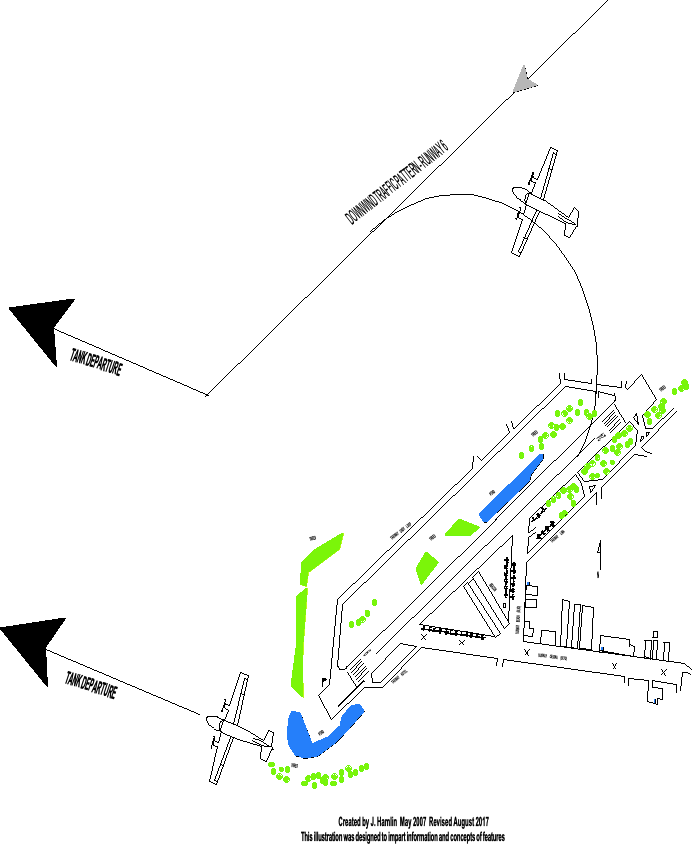
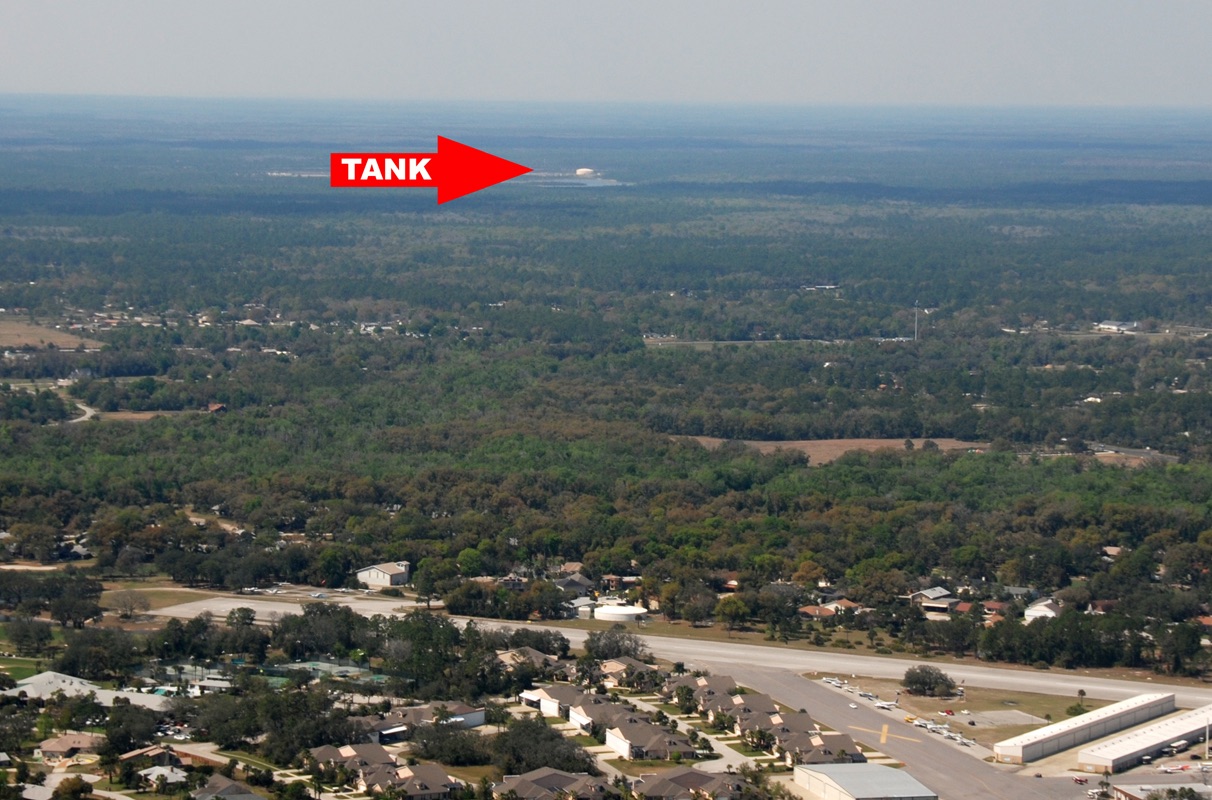
2022.4.19

